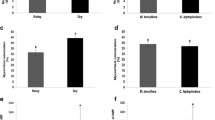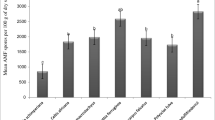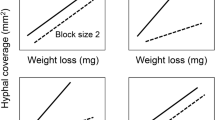Abstract
Fungi are a major component of soil biota in terrestrial ecosystems of various climatic regions, but few studies have compared the effects of soil layer and season on their abundance between sites with different humus forms and climatic conditions. In the present study, the hyphal length in the forest floor and soil was investigated in subtropical (ST), cool temperate (CT), and subalpine (SA) forests in Japan with an agar film method. The primary aim was to describe the seasonal variations in hyphal length in different layers of mull and moder humus forms in forests of these three climatic regions. The total hyphal length was generally higher in CT than in ST and SA and decreased with the soil depth. Seasonal changes in total hyphal length were observed in ST and in the lower slope of CT where mull humus developed. The length of darkly pigmented hyphae and the proportion of them relative to the total hyphal length were higher at the upper slope of the CT forest (moder humus) than at the other sites, and decreased in the order F > L > A layers. Clamp-bearing hyphal length in Basidiomycota accounted for as much as 19 % of the total hyphal length and decreased with the depth of the forest floor and soil in all study sites. Seasonal changes of hyphal length and the layer × month interaction were significant on mull but not on moder humus, suggesting that hyphal length was more sensitive to season in mull than in moder humus.




Similar content being viewed by others
References
Bååth E, Söderström BE (1977) Mycelial lengths and fungal biomasses in some Swedish coniferous forest soils, with special reference to a pine forest in central Sweden. Swed Conifer For Proj Tech Rep 13:1–45
Berg B, Söderström B (1979) Fungal biomass and nitrogen in decomposing Scots pine needle litter. Soil Biol Biochem 11:339–341
Boddy L, Frankland JC, van West P (2008) Ecology of saprotrophic basidiomycetes. Academic, London
Butler MJ, Day AW (1998) Fungal melanins: a review. Can J Microbiol 44:1115–1136
Dix NJ, Webster J (1995) Fungal ecology. Chapman and Hall, London
Enoki T (2003) Microtopography and distribution of canopy trees in a subtropical evergreen broad-leaved forest in the northern part of Okinawa Island, Japan. Ecol Res 18:103–113
Fioretto A, Musacchio A, Andolft G, Virzo de Santo A (1998) Decomposition dynamics of litters of various pine species in a Corsican pine forest. Soil Biol Biochem 30:721–757
Frankland JC, Hedger JN, Swift Mj (1982) Biomass and nutrient cycling by decomposer basidiomycetes. Decomposer basidiomycetes, their biology and ecology. Cambridge University Press, Cambridge, pp 241–261
Hobara S, Osono T, Hirose D, Noro K, Hirota M, Benner R (2014) The roles of microorganisms in litter decomposition and soil formation. Biogeochemistry 118:471–486
Holden SR, Gutierrez A, Treseder KK (2013) Soil fungal communities, extracellular enzyme activities, and litter decomposition across a fire chronosequence in Alaskan boreal forests. Ecosystems 16:34–46
Hunt GA, Fogel R (1983) Fungal hyphal dynamics in a western Oregon Douglas-fir stand. Soil Biol Biochem 15:641–649
Jones PCT, Mollison JE (1948) A technique for the quantitative estimation of soil microorganisms. J Gen Microbiol 2:54–69
Kjøller A, Struwe S (1982) Microfungi in ecosystems: fungal occurrence and activity in litter and soil. Oikos 39:391–422
Koide K, Osono T, Takeda H (2005) Fungal succession and decomposition of Camellia japonica leaf litter. Ecol Res 20:599–609
Mori A, Mizumachi E, Osono T, Doi Y (2004) Substrate-associated seedling recruitment and establishment of major conifer species in an old-growth subalpine forest in central Japan. For Ecol Manag 196:287–297
Newell SY (1992) Estimating fungal biomass and productivity in decomposing litter. In: Carroll GC, Wicklow DT (eds) The fungal community: its organization and role in the ecosystem. Marcel Dekker, New York, pp 521–561
Olson FCW (1950) Quantitative estimates of filamentous algae. T Am Microsc Soc 69:272–279
Osono T (2005) Colonization and succession of fungi during decomposition of Swida controversa leaf litter. Mycologia 97:589–597
Osono T (2007) Ecology of ligninolytic fungi associated with leaf litter decomposition. Ecol Res 22:955–974
Osono T (2011) Diversity and functioning of fungi associated with leaf litter decomposition in Asian forests of different climatic regions. Fungal Ecol 4:375–385
Osono T (2014) Diversity, resource utilization, and phenology of fruiting bodies of litter-decomposing macrofungi in subtropical, temperate, and subalpine forests. J For Res (accepted for publication)
Osono T, Takeda H (2001) Organic chemical and nutrient dynamics in decomposing beech leaf litter in relation to fungal ingrowth and succession during 3 year decomposition processes in a cool temperate deciduous forest in Japan. Ecol Res 16:649–670
Osono T, Takeda H (2007) Microfungi associated with Abies needles and Betula leaf litter in a subalpine coniferous forest. Can J Microbiol 53:1–7
Osono T, Hobara S, Fujiwara S, Koba K, Kameda K (2002) Abundance, diversity, and species composition of fungal communities in a temperate forest affected by excreta of the Great Cormorant Phalacrocorax carbo. Soil Biol Biochem 34:1537–1547
Osono T, Ono Y, Takeda H (2003) Fungal ingrowth on forest floor and decomposing needle litter of Chamaecyparis obtusa in relation to resource availability and moisture condition. Soil Biol Biochem 35:1423–1431
Osono T, Hirose D, Fujimaki R (2006) Fungal colonization as affected by litter depth and decomposition stage of needle litter. Soil Biol Biochem 38:2743–2752
Osono T, Takeda H, Azuma JI (2008a) Carbon isotope dynamics during leaf litter decomposition in a cool temperate forest with reference to lignin fractions. Ecol Res 23:51–55
Osono T, Ishii Y, Takeda H (2008b) Fungal colonization and decomposition of Castanopsis sieboldii leaves in a subtropical forest. Ecol Res 23:909–917
Osono T, Ishii Y, Takeda H, Seramethakun T, Khamyong S, To-Anun C, Hirose D, Tokumasu S, Kakishima M (2009) Fungal succession and lignin decomposition on Shorea obtusa leaves in a tropical seasonal forest in northern Thailand. Fungal Divers 36:101–119
Osono T, Hobara S, Hishinuma T, Azuma JI (2011) Selective lignin decomposition and nitrogen mineralization in forest litter colonized by Clitocybe sp. Eur J Soil Biol 47:114–121
Osono T, Ueno T, Uchida M, Kanda H (2012) Abundance and diversity of fungi in relation to chemical changes in arctic moss profiles. Polar Sci 6:121–131
Osono T, Matsuoka S, Hirose D, Uchida M, Kanda H (2014) Fungal colonization and decomposition of leaves and stems of Salix arctica on deglaciated moraines in high-Arctic Canada. Polar Sci 8(2):207–216
Robinson CH, Borisova OB, Callaghan TV, Lee JA (1996) Fungal hyphal length in litter of Dryas octopetala in a high-Arctic polar semi-desert, Svalbard. Polar Biol 16:71–74
Ruscoe QW (1971) The soil mycoflora of a hard beech forest. NZ J Sci 14:554–567
Takeda H, Kaneko N (1988) Patterns of soil humus accumulation in forests. I. Mull and moder types humus in a broad-leaved forest. Bull Kyoto Univ Forest 60:33–45 (in Japanese with English abstract)
Tateno R, Takeda H (2003) Forest structure and tree species distribution in relation to topography-mediated heterogeneity of soil nitrogen and light at the forest floor. Ecol Res 18:559–571
Tian X, Takeda H, Ando T (1997) Application of a rapid thin section method for observations on decomposing litter in mor humus form in a subalpine coniferous forest. Ecol Res 12:289–300
Tokumasu S (1998) Fungal successions on pine needles fallen at different seasons: the succession of surface colonizers. Mycoscience 39:417–423
Tsukamoto J (1996) Soil macro-invertebrates and litter disappearance in a Japanese mixed deciduous forest and comparison with European deciduous forests and tropical rainforests. Ecol Res 11:35–50
van der Wal A, Bloem J, Mulder C, de Boer W (2009) Relative abundance and activity of melanized hyphae in different soil ecosystems. Soil Biol Biochem 41:417–419
West AW (1988) Specimen preparation, stain type, and extraction and observation procedures as factors in the estimation of soil mycelial lengths and volumes by light microscopy. Biol Fertil Soils 7:88–94
Widden P, Parkinson D (1979) Populations of fungi in a high arctic ecosystem. Can J Bot 57:2408–2417
Acknowledgments
I thank Dr. A. Takashima and staff at the Yona Experimental Forest, University of the Ryukyus, for help with fieldwork at ST; the staff at Ashiu Experimental Forest, Kyoto University, for help with fieldwork at CT; and Dr. Elizabeth Nakajima for her critical reading of the manuscript. This study received partial financial support from the Ministry of Education, Culture, Sports, Science, and Technology of Japan (MEXT) (No. 19780114), The Sumitomo Foundation, Nissan Global Foundation, Nippon Life Inst. Foundation, and Grants for Excellent Graduate Schools, MEXT, Japan (12-01) to Kyoto University.
Author information
Authors and Affiliations
Corresponding author
Electronic supplementary material
Below is the link to the electronic supplementary material.
About this article
Cite this article
Osono, T. Hyphal length in the forest floor and soil of subtropical, temperate, and subalpine forests. J For Res 20, 69–76 (2015). https://doi.org/10.1007/s10310-014-0461-2
Received:
Accepted:
Published:
Issue Date:
DOI: https://doi.org/10.1007/s10310-014-0461-2




